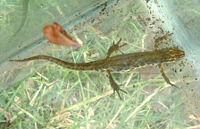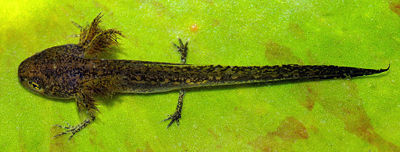Newt
| Newts | ||||||||||
|---|---|---|---|---|---|---|---|---|---|---|
 Smooth Newt (Triturus vulgaris)
| ||||||||||
| Scientific classification | ||||||||||
|
Newts (also called efts when terrestrial) are an informal grouping of salamanders within the Salamandridae family that may have rough-textured skin when terrestrial, unlike other salamanders, and whose rib or costal grooves along the sides of the body usually are not distinct.
The family Salamandridae is informally divided into two groups, the newts and the "true salamanders" (Larson et al. 2007). True salamanders are generally considered to include the genera Salamandra, Lyciasalamandra, Clioglossa, and Mertensiella, while newts include all of the more than ten remaining extant genera (Larson et al. 2007). While both groups of amphibians have aquatic larva, adults of true salamanders are highly terrestrial, whereas the newts are at least partly aquatic and some are entirely aquatic (Larson et al. 2007). Terrestrial newts also must return to the water to reproduce.
In addition to their ecological importance in food chains in many ecosystems, newts' unique adaptations, such as toxins, ability to regenerate, and often bright coloration, add benefit to humans, whether the human enjoyment of the diversity of nature or the use of newts in medical and scientific research, including embryology, physiology, and development biology. Newts also consume insects, such as mosquitoes, and other pests and disease vectors. Despite these values, many newts are endangered, largely due to habitat loss.
Characteristics
Newts are not a formal taxa. Unlike all other salamanders (order Caudata), newts have rough-textured skin that is not slimy (Larson et al. 2007). Like most salamandrids (members of Salamandridae), they have a biphasic life cycle with aquatic larvae, with four pairs of gills slits and large external gills, which then undergo metamorphosis into adults that may be terrestrial or aquatic and that have legs that are relatively long, prominent, and robust (Larson et al. 2007). However, some newts have a complex life cycle, with two metamorphoses and three development stages, proceeding from aquatic larva, to a terrestrial juvenile ("red eft"), and finally a secondarily aquatic adult (Larson et al. 2007).
All newts have aquatic larvae and some are strictly aquatic as adults, while others are terrestrial as adults, but return to ponds or streams to reproduce (Larson et al. 2007).
Newts can take several years to reach sexual maturity. For many, their main breeding season is between February and June. They hatch as tadpoles from eggs laid in ponds or slow-moving streams. In the case of triturus, even brackish water is used, but most species are more selective. Then, they undergo metamorphosis, during which they commonly leave the water. Some return to the water to live out their adult lives. During the time right after metamorphosis, many North American newt species go through a phase called the eft phase. Efts always live their lives on land and are rarely seen in the water. In some cases, metamorphosis to the eft stage involves a change in the skin color. When the eft reaches adulthood, it may begin to live its life in a more aquatic fashion, and this secondarily aquatic form may rarely venture onto land. Many newts will live out their adulthood on land and only visit water to breed.
Salamandrids all have toxic skin secretions and newts are highly poisonous in all stages of their life cycle (Larson et al. 2007). This serves as a defense mechanism against predators. In order to cause harm, the toxins have to enter the body by being ingested or entering a break in the skin. The alligator newt (Echinotriton andersoni) of Japan, when grabbed, extends its sharp ribs through its poison glands and directly through the skin of the attacker, injecting the toxin. Taricha newts of western North America are particularly toxic; the Rough-skinned Newt (Taricha granulosa) of the Pacific Northwest region of the United States produces more than enough tetrodotoxin to kill an adult human foolish enough to swallow a newt.
Newts have the ability to regenerate limbs, eyes, spinal cords, hearts, intestines, and upper and lower jaws. The cells at the site of the injury have the ability to de-differentiate, reproduce rapidly, and differentiate again to create a new limb or organ. One theory is that the de-differentiated cells are related to tumor cells since chemicals that produce tumors in other animals will produce additional limbs in newts (Odelberg 2007).
Distribution
Newts are widespread in distribution, covering much of Europe and with species in North America, China, Laos, Vietnam, Japan, Middle East, and northwestern Africa (Larson et al. 2007).
The three common European genera are the crested newts (Triturus sp.), the European newts (Tylotriton sp.), the banded newts (Ommatotriton sp.), and some individuals such as the Spanish Ribbed Newt (Plurodeles waltl), the largest newt, and the Alpine newt (Mesotriton alpestris).
In North America, there are the Eastern newts (Notophthalmus sp.), of which the red-spotted newt (Notophthalmus viridescens) is the most abundant species, but it is limited to the area east of the Rocky Mountains. The three species of coastal, or Western newts are the red-bellied newt, the California Newt, and the rough-skinned newt, all of which belong to the genus Taricha, which is confined to the area west of the Rockies.
In Southeast Asia and Japan, species commonly encountered in the pet trade include the firebelly newts (Cynops sp.), the paddletail newts (Pachytriton sp.), the crocodile newts (Tylototriton sp.), and the warty newts (Paramesotriton sp.). In the Middle East, there are the Middle Eastern newts (Neurergus sp.) (Miller 2006).
Etymology
The oldest form of the name newt is considered to be eft, which is still used for newly metamorphosed juveniles. According to some reports, it changed for unknown reasons to ewt, and was used as "an ewt," but the "n" from the indefinite article (an) shifted to form a newt. Others place the change from "an eft" to "a neft" with the letter f eventually transformed to "w."
ReferencesISBN links support NWE through referral fees
- Griffiths, R. 1996. Newts and Salamanders of Europe. London: Academic Press. ISBN 012303955X
- Larson, A., D. Wake, and T. Devitt. 2007. Salamandridae. Newts and "true salamanders." Version 24 (under construction). Tree of Life Web Project.
- Miller, J. J. 2006. Order: Caudata. Livingunderworld.org. Retrieved February 5, 2007.
- Odelberg, S. 2007. Research from the Molecular Biology Program Bioscience Graduate Studies, University of Utah. Retrieved January 24, 2007.
External Links
All links retrieved November 14, 2022.
Credits
New World Encyclopedia writers and editors rewrote and completed the Wikipedia article in accordance with New World Encyclopedia standards. This article abides by terms of the Creative Commons CC-by-sa 3.0 License (CC-by-sa), which may be used and disseminated with proper attribution. Credit is due under the terms of this license that can reference both the New World Encyclopedia contributors and the selfless volunteer contributors of the Wikimedia Foundation. To cite this article click here for a list of acceptable citing formats.The history of earlier contributions by wikipedians is accessible to researchers here:
The history of this article since it was imported to New World Encyclopedia:
Note: Some restrictions may apply to use of individual images which are separately licensed.
